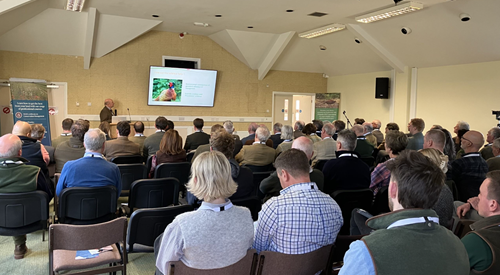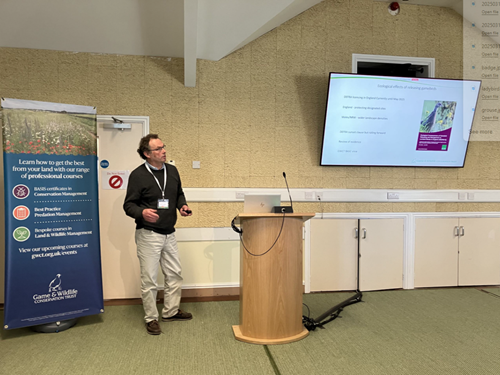Scientific research, practitioner evidence and environmental accreditation are essential for sustainable game management -- the take home message from GWCT’s lowland gamebird conference.
GWCT chairman Sir Jim Paice introduced the conference by saying that while there are currently no indications that the Government is going to restrict lowland gamebird shooting in England, the sector should avoid complacency as the political landscape can shift quickly. It is, therefore, more important than ever to communicate the financial contribution it makes to conservation. The 2024/2025 SFI budget was closed at £1.05billion, while the 2024 Value of Shooting survey showed shooting contributes £0.5billion to nature recovery.
Sir Jim went on to outline the central theme of the conference that scientific research, practitioner evidence and data, and shoot accreditation are essential to demonstrate to policy makers that best practice game management as an essential tool to achieve biodiversity net gain and nature recovery on a landscape scale.
In Dr Roger Draycott’s policy update on licencing, he highlighted that GWCT research on pheasant dispersal had prevented restrictions on releasing on designated sites during the AI outbreak in 2023. In making the case, he had also been able to draw on practitioner science in the form of the Big Farmland Bird Count which showed that farms with game shoots had more songbirds than those without and there was, therefore, a risk to nature recovery of restricting game management.
Director of Trusted Game Mark Elliot explained that the accreditation scheme was originally intended to bring pheasant and partridge releasing in line with the agricultural sector in terms of assuring welfare standards and reduction in antibiotic use. Aimed at meeting best practice standards in and around the release pen, the scheme has already proved helpful to shoots applying for licences by providing evidence of compliance with the various legal requirements and codes of practice. One of its goals is to help end the use of prophylactic antibiotics in gamebird management through a combination of improved hygiene, biosecurity and reduced stocking densities.
Tim Weston of the National Gamekeepers Organisation focussed on the importance of everyone playing a part in maintaining a positive perception of game shooting in order to maintain social licence. By gathering practitioner data and evidence, shoots can avoid bringing the sector into disrepute and instead prove they are following best practice and achieving a biodiversity net gain. Acts such as fly tipping dead game or flouting the rules on the use of lead ammunition do so much damage to the reputation of shooting and obscure its value to environment, economy and community.

‘Quality not quantity’
Digby Taylor of Guns on Pegs (GoP) and Nick Watson of Strutt and Parker both made the point that, in their experience, running a successful shoot is more about quality than quantity. Digby said GoP surveys suggest that for most Guns, an ideal shoot day is primarily about fun with friends, so a focus on quality hospitality is key. Digby said that most days sold through GoP are around the 150 bird mark and there is not a great appetite for high bird days. He added that Guns value the experience of wildlife in the countryside, conservation activity and evidence of best practice, so it’s important for shoot managers and gamekeepers to engage with their guests and explain the good work they are doing.
Nick made the point that reducing numbers of birds on the ground could increase returns and therefore reduce costs. He also pointed to examples of shoots beginning to charge a fixed price for the day rather than the number of birds.
The Country Food Trust takes gamebirds and venison and turns the meat into meals that are then distributed to food banks around the country. Presenting at the conference, its director SJ Hunt said one of the charity’s main goals is making sure that all birds shot are eaten, emphasising that the sector needs to work together to make that happens, in particular, switching to non-lead shot. She said:
“We need to import fewer live gamebirds and export less meat. At the moment, many game dealers are sending 95% of their gamebird meat overseas and that means that we can't get hold of it to do the work that we need to do in this country.”
Jeremy Marsh from Elanco described the work they had done to develop better treatment for parasitic worms. He encouraged a more nuanced approach to administering wormers in keeping with the warmer winters and emphasised pen hygiene and management as critical to avoiding infestations.
Dr Rufus Sage, senior lowland game scientist at GWCT, explained how in recent years the focus of the Trust’s research had moved from gamebird health and management to countering false accusations from opponents of game shooting and proving the benefits to wildlife and the wider countryside in response to the growing move towards stricter licensing. He cited the examples of past research on dispersal of pheasants and impact of release pen densities on woodland flora and invertebrates. More recent projects have shown 50% more breeding songbirds in hedges up to 500m from game crops and no evidence of increase in fox activity on farms with shoots. Rufus highlighted the danger of anti-shooting organisations coopting ecological arguments to call for restrictions on releasing, but was encouraged by DEFRA’s reliance on GWCT science to inform its recent handling of licence applications.

Harnessing technology to support shoot managers to gather evidence was the theme of Dave Butler and Jodie Case’s presentation on the new Perdix Pro App due to be launched in April. The system offers an Internet of things (IoT) which can bring together a range of useful software from data capture to mapping and video/photography enabling gamekeepers to log everything from trap lines to wildlife sightings. Data analysis provided by the programme ensures greater efficiency and can produce instant reports demonstrating adherence to regulations, best practice and evidence of biodiversity net gain.
In the final presentation of the day Matt Goodall GWCT Head of Education, who ran the conference, highlighted the risk that a failure of self-regulation on the part of the shooting community will lead to further licencing. He pointed to the potential for pheasant shooting to be licenced under the Wildlife Management and Muirburn (Scotland) Bill and the move towards licensing in Wales as scenarios that could happen in England in the future. Returning to the key themes of the conference he warned of the risk of complacency and the urgent need to gather more and consistent evidence to prove the conservation credentials of sustainable game management, which is an increasingly important line of defence. Those on the ground can see that best practice game management delivers for nature but a statement without data to back it up will only be regarded as an opinion by policymakers.